Case Study: Managing Change and Building Brand Culture at Burger U
VerifiedAdded on 2023/03/17
|16
|4947
|56
Case Study
AI Summary
This case study examines the transformation of Burger U (formerly Wild Man Burgers) in Australia, focusing on managing change and building a new brand culture. The analysis delves into the challenges faced by the company, including declining profits and changing consumer preferences for healthier food options. The report outlines the strategies implemented by Ciara, including rebranding efforts, new product offerings, employee training, and marketing campaigns. It explores the impact of these changes on the company's brand culture, internal operations, and customer relationships. The study assesses Ciara's effectiveness in managing the transformation, identifies potential areas for improvement, and highlights the importance of aligning marketing and communication strategies with the new brand culture. Furthermore, the analysis underscores the significance of employee engagement, leadership, and corporate social responsibility in the successful repositioning of a brand. The case study also discusses the recruitment and selection processes, emphasizing the need for skilled candidates to sustain the new brand culture.
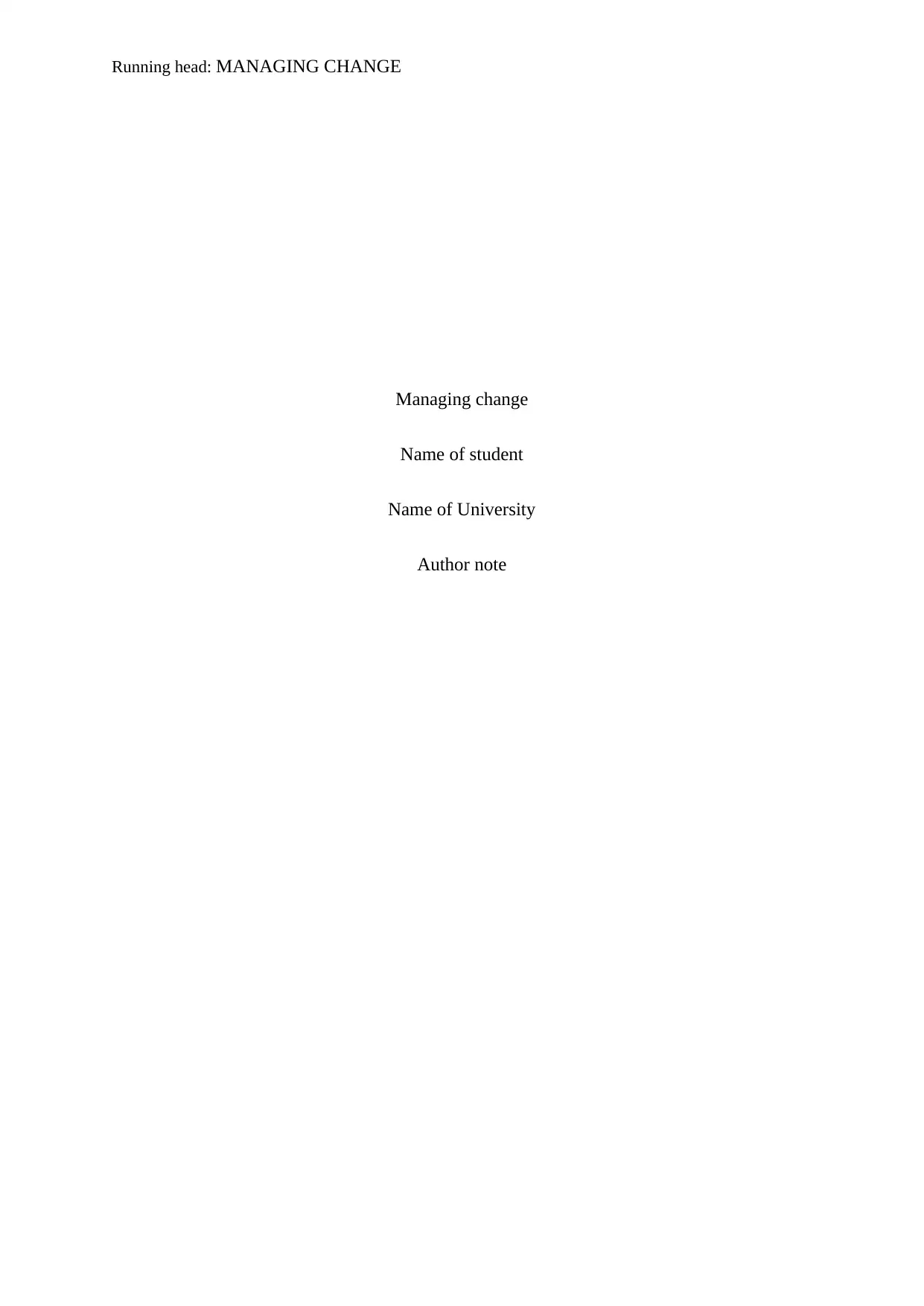
Running head: MANAGING CHANGE
Managing change
Name of student
Name of University
Author note
Managing change
Name of student
Name of University
Author note
Paraphrase This Document
Need a fresh take? Get an instant paraphrase of this document with our AI Paraphraser
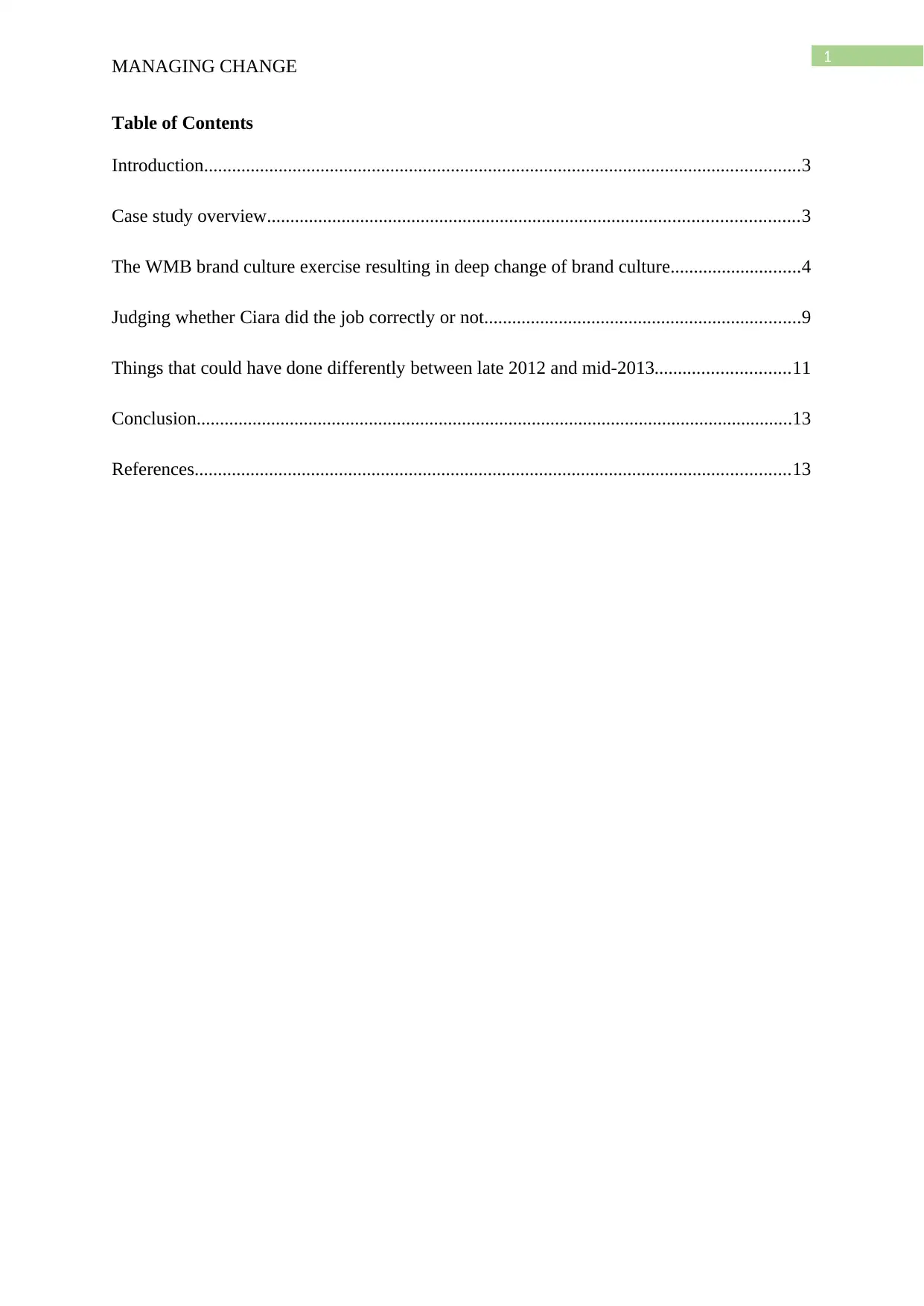
1
MANAGING CHANGE
Table of Contents
Introduction................................................................................................................................3
Case study overview..................................................................................................................3
The WMB brand culture exercise resulting in deep change of brand culture............................4
Judging whether Ciara did the job correctly or not....................................................................9
Things that could have done differently between late 2012 and mid-2013.............................11
Conclusion................................................................................................................................13
References................................................................................................................................13
MANAGING CHANGE
Table of Contents
Introduction................................................................................................................................3
Case study overview..................................................................................................................3
The WMB brand culture exercise resulting in deep change of brand culture............................4
Judging whether Ciara did the job correctly or not....................................................................9
Things that could have done differently between late 2012 and mid-2013.............................11
Conclusion................................................................................................................................13
References................................................................................................................................13
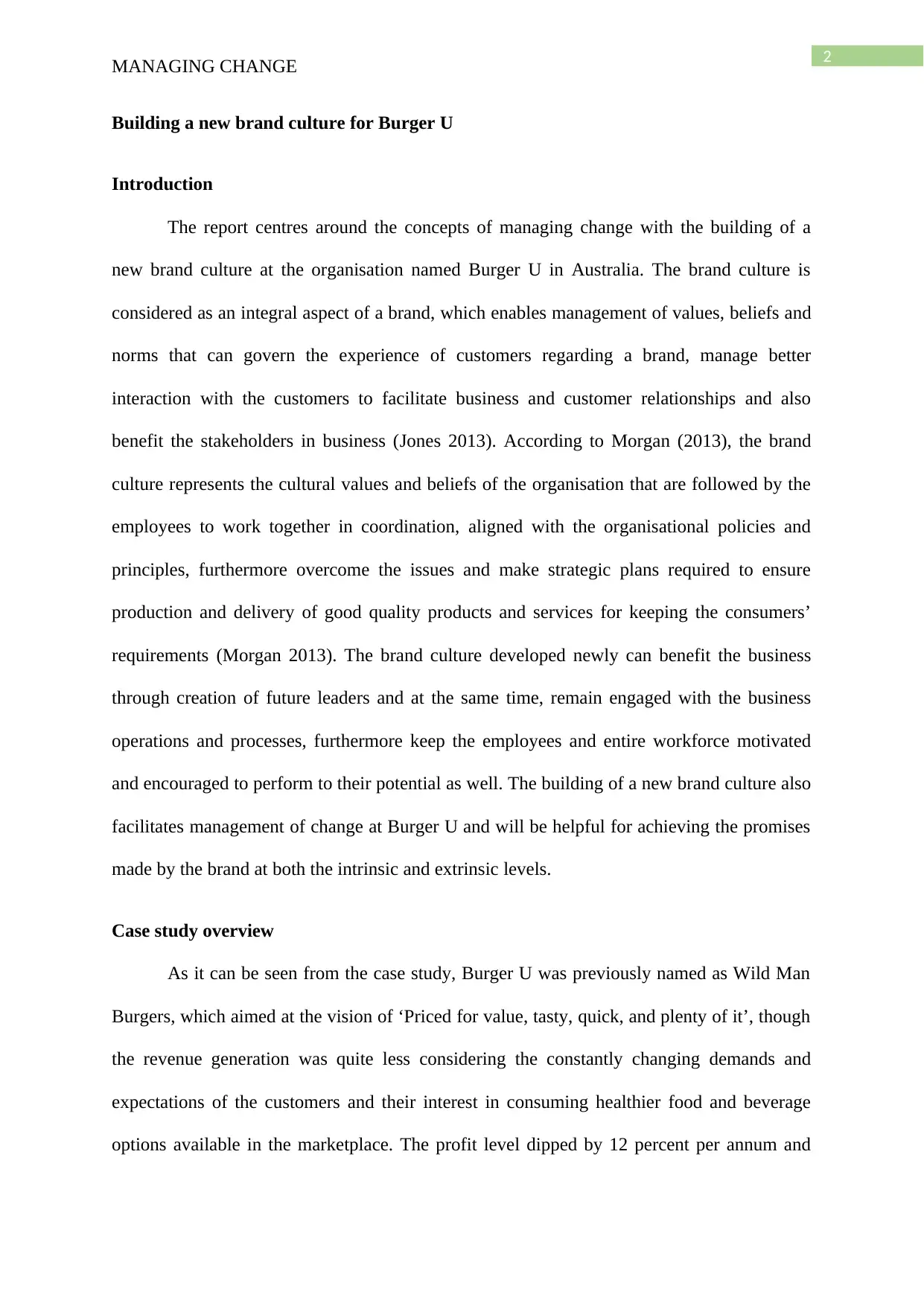
2
MANAGING CHANGE
Building a new brand culture for Burger U
Introduction
The report centres around the concepts of managing change with the building of a
new brand culture at the organisation named Burger U in Australia. The brand culture is
considered as an integral aspect of a brand, which enables management of values, beliefs and
norms that can govern the experience of customers regarding a brand, manage better
interaction with the customers to facilitate business and customer relationships and also
benefit the stakeholders in business (Jones 2013). According to Morgan (2013), the brand
culture represents the cultural values and beliefs of the organisation that are followed by the
employees to work together in coordination, aligned with the organisational policies and
principles, furthermore overcome the issues and make strategic plans required to ensure
production and delivery of good quality products and services for keeping the consumers’
requirements (Morgan 2013). The brand culture developed newly can benefit the business
through creation of future leaders and at the same time, remain engaged with the business
operations and processes, furthermore keep the employees and entire workforce motivated
and encouraged to perform to their potential as well. The building of a new brand culture also
facilitates management of change at Burger U and will be helpful for achieving the promises
made by the brand at both the intrinsic and extrinsic levels.
Case study overview
As it can be seen from the case study, Burger U was previously named as Wild Man
Burgers, which aimed at the vision of ‘Priced for value, tasty, quick, and plenty of it’, though
the revenue generation was quite less considering the constantly changing demands and
expectations of the customers and their interest in consuming healthier food and beverage
options available in the marketplace. The profit level dipped by 12 percent per annum and
MANAGING CHANGE
Building a new brand culture for Burger U
Introduction
The report centres around the concepts of managing change with the building of a
new brand culture at the organisation named Burger U in Australia. The brand culture is
considered as an integral aspect of a brand, which enables management of values, beliefs and
norms that can govern the experience of customers regarding a brand, manage better
interaction with the customers to facilitate business and customer relationships and also
benefit the stakeholders in business (Jones 2013). According to Morgan (2013), the brand
culture represents the cultural values and beliefs of the organisation that are followed by the
employees to work together in coordination, aligned with the organisational policies and
principles, furthermore overcome the issues and make strategic plans required to ensure
production and delivery of good quality products and services for keeping the consumers’
requirements (Morgan 2013). The brand culture developed newly can benefit the business
through creation of future leaders and at the same time, remain engaged with the business
operations and processes, furthermore keep the employees and entire workforce motivated
and encouraged to perform to their potential as well. The building of a new brand culture also
facilitates management of change at Burger U and will be helpful for achieving the promises
made by the brand at both the intrinsic and extrinsic levels.
Case study overview
As it can be seen from the case study, Burger U was previously named as Wild Man
Burgers, which aimed at the vision of ‘Priced for value, tasty, quick, and plenty of it’, though
the revenue generation was quite less considering the constantly changing demands and
expectations of the customers and their interest in consuming healthier food and beverage
options available in the marketplace. The profit level dipped by 12 percent per annum and
⊘ This is a preview!⊘
Do you want full access?
Subscribe today to unlock all pages.

Trusted by 1+ million students worldwide
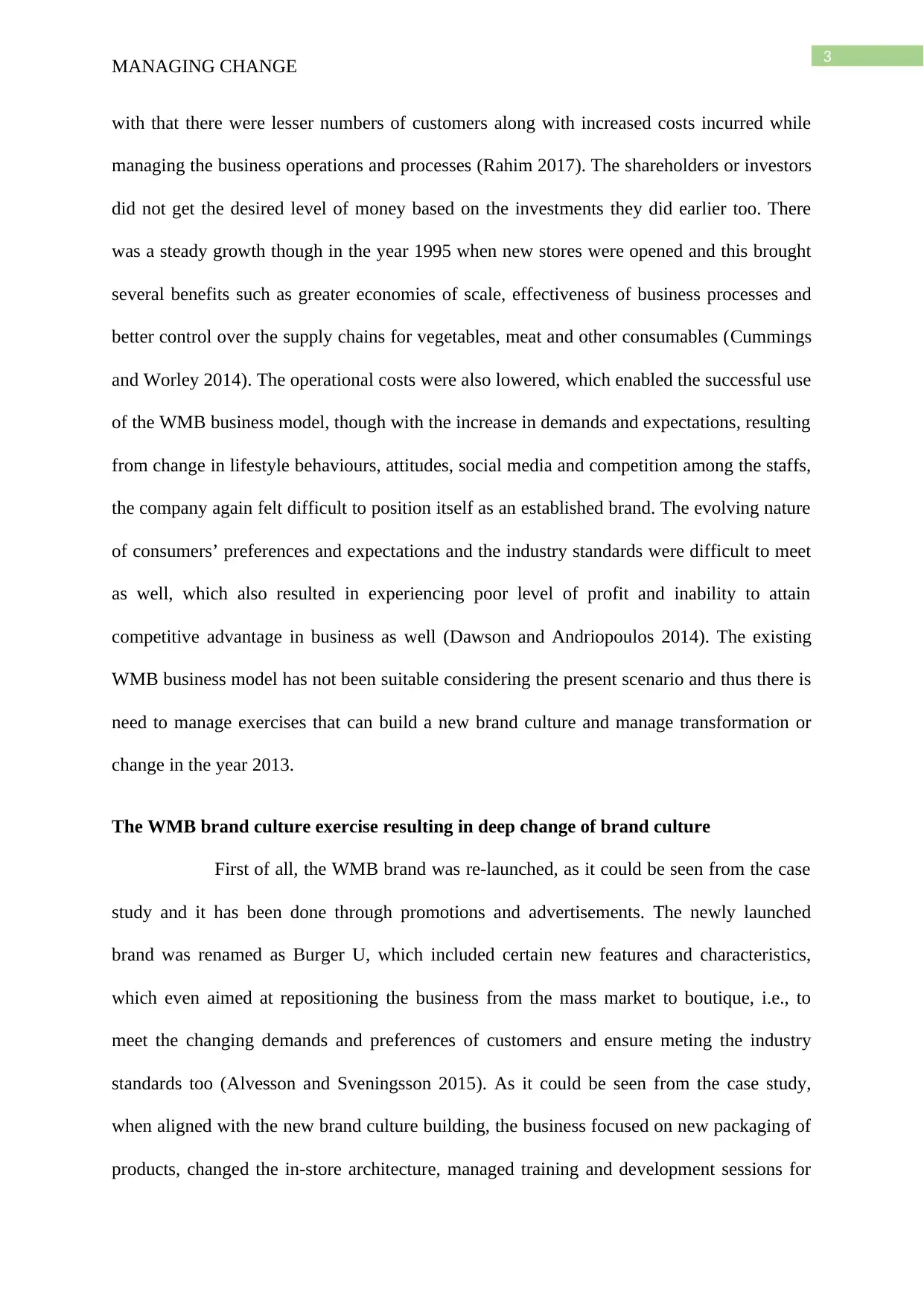
3
MANAGING CHANGE
with that there were lesser numbers of customers along with increased costs incurred while
managing the business operations and processes (Rahim 2017). The shareholders or investors
did not get the desired level of money based on the investments they did earlier too. There
was a steady growth though in the year 1995 when new stores were opened and this brought
several benefits such as greater economies of scale, effectiveness of business processes and
better control over the supply chains for vegetables, meat and other consumables (Cummings
and Worley 2014). The operational costs were also lowered, which enabled the successful use
of the WMB business model, though with the increase in demands and expectations, resulting
from change in lifestyle behaviours, attitudes, social media and competition among the staffs,
the company again felt difficult to position itself as an established brand. The evolving nature
of consumers’ preferences and expectations and the industry standards were difficult to meet
as well, which also resulted in experiencing poor level of profit and inability to attain
competitive advantage in business as well (Dawson and Andriopoulos 2014). The existing
WMB business model has not been suitable considering the present scenario and thus there is
need to manage exercises that can build a new brand culture and manage transformation or
change in the year 2013.
The WMB brand culture exercise resulting in deep change of brand culture
First of all, the WMB brand was re-launched, as it could be seen from the case
study and it has been done through promotions and advertisements. The newly launched
brand was renamed as Burger U, which included certain new features and characteristics,
which even aimed at repositioning the business from the mass market to boutique, i.e., to
meet the changing demands and preferences of customers and ensure meting the industry
standards too (Alvesson and Sveningsson 2015). As it could be seen from the case study,
when aligned with the new brand culture building, the business focused on new packaging of
products, changed the in-store architecture, managed training and development sessions for
MANAGING CHANGE
with that there were lesser numbers of customers along with increased costs incurred while
managing the business operations and processes (Rahim 2017). The shareholders or investors
did not get the desired level of money based on the investments they did earlier too. There
was a steady growth though in the year 1995 when new stores were opened and this brought
several benefits such as greater economies of scale, effectiveness of business processes and
better control over the supply chains for vegetables, meat and other consumables (Cummings
and Worley 2014). The operational costs were also lowered, which enabled the successful use
of the WMB business model, though with the increase in demands and expectations, resulting
from change in lifestyle behaviours, attitudes, social media and competition among the staffs,
the company again felt difficult to position itself as an established brand. The evolving nature
of consumers’ preferences and expectations and the industry standards were difficult to meet
as well, which also resulted in experiencing poor level of profit and inability to attain
competitive advantage in business as well (Dawson and Andriopoulos 2014). The existing
WMB business model has not been suitable considering the present scenario and thus there is
need to manage exercises that can build a new brand culture and manage transformation or
change in the year 2013.
The WMB brand culture exercise resulting in deep change of brand culture
First of all, the WMB brand was re-launched, as it could be seen from the case
study and it has been done through promotions and advertisements. The newly launched
brand was renamed as Burger U, which included certain new features and characteristics,
which even aimed at repositioning the business from the mass market to boutique, i.e., to
meet the changing demands and preferences of customers and ensure meting the industry
standards too (Alvesson and Sveningsson 2015). As it could be seen from the case study,
when aligned with the new brand culture building, the business focused on new packaging of
products, changed the in-store architecture, managed training and development sessions for
Paraphrase This Document
Need a fresh take? Get an instant paraphrase of this document with our AI Paraphraser
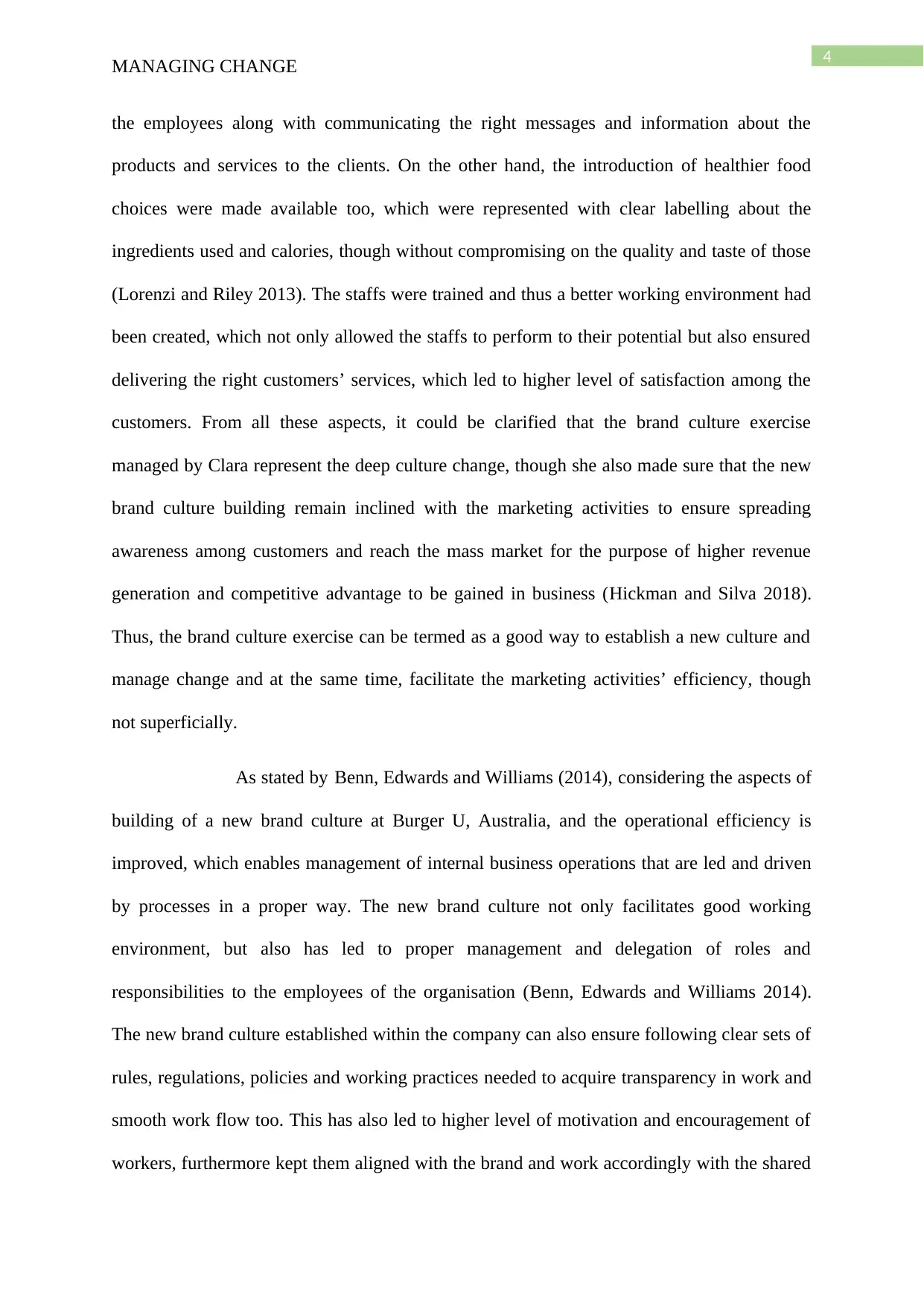
4
MANAGING CHANGE
the employees along with communicating the right messages and information about the
products and services to the clients. On the other hand, the introduction of healthier food
choices were made available too, which were represented with clear labelling about the
ingredients used and calories, though without compromising on the quality and taste of those
(Lorenzi and Riley 2013). The staffs were trained and thus a better working environment had
been created, which not only allowed the staffs to perform to their potential but also ensured
delivering the right customers’ services, which led to higher level of satisfaction among the
customers. From all these aspects, it could be clarified that the brand culture exercise
managed by Clara represent the deep culture change, though she also made sure that the new
brand culture building remain inclined with the marketing activities to ensure spreading
awareness among customers and reach the mass market for the purpose of higher revenue
generation and competitive advantage to be gained in business (Hickman and Silva 2018).
Thus, the brand culture exercise can be termed as a good way to establish a new culture and
manage change and at the same time, facilitate the marketing activities’ efficiency, though
not superficially.
As stated by Benn, Edwards and Williams (2014), considering the aspects of
building of a new brand culture at Burger U, Australia, and the operational efficiency is
improved, which enables management of internal business operations that are led and driven
by processes in a proper way. The new brand culture not only facilitates good working
environment, but also has led to proper management and delegation of roles and
responsibilities to the employees of the organisation (Benn, Edwards and Williams 2014).
The new brand culture established within the company can also ensure following clear sets of
rules, regulations, policies and working practices needed to acquire transparency in work and
smooth work flow too. This has also led to higher level of motivation and encouragement of
workers, furthermore kept them aligned with the brand and work accordingly with the shared
MANAGING CHANGE
the employees along with communicating the right messages and information about the
products and services to the clients. On the other hand, the introduction of healthier food
choices were made available too, which were represented with clear labelling about the
ingredients used and calories, though without compromising on the quality and taste of those
(Lorenzi and Riley 2013). The staffs were trained and thus a better working environment had
been created, which not only allowed the staffs to perform to their potential but also ensured
delivering the right customers’ services, which led to higher level of satisfaction among the
customers. From all these aspects, it could be clarified that the brand culture exercise
managed by Clara represent the deep culture change, though she also made sure that the new
brand culture building remain inclined with the marketing activities to ensure spreading
awareness among customers and reach the mass market for the purpose of higher revenue
generation and competitive advantage to be gained in business (Hickman and Silva 2018).
Thus, the brand culture exercise can be termed as a good way to establish a new culture and
manage change and at the same time, facilitate the marketing activities’ efficiency, though
not superficially.
As stated by Benn, Edwards and Williams (2014), considering the aspects of
building of a new brand culture at Burger U, Australia, and the operational efficiency is
improved, which enables management of internal business operations that are led and driven
by processes in a proper way. The new brand culture not only facilitates good working
environment, but also has led to proper management and delegation of roles and
responsibilities to the employees of the organisation (Benn, Edwards and Williams 2014).
The new brand culture established within the company can also ensure following clear sets of
rules, regulations, policies and working practices needed to acquire transparency in work and
smooth work flow too. This has also led to higher level of motivation and encouragement of
workers, furthermore kept them aligned with the brand and work accordingly with the shared
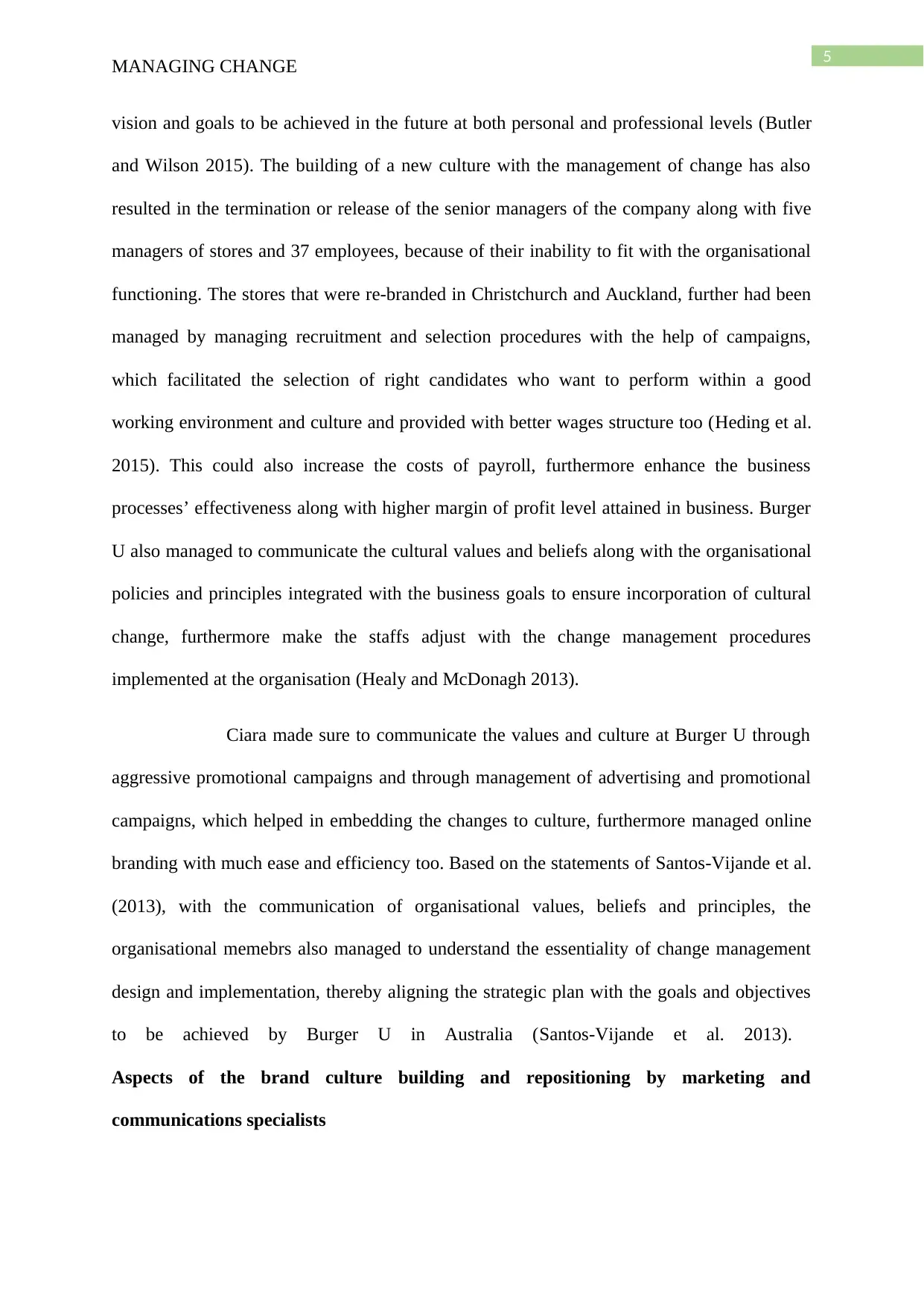
5
MANAGING CHANGE
vision and goals to be achieved in the future at both personal and professional levels (Butler
and Wilson 2015). The building of a new culture with the management of change has also
resulted in the termination or release of the senior managers of the company along with five
managers of stores and 37 employees, because of their inability to fit with the organisational
functioning. The stores that were re-branded in Christchurch and Auckland, further had been
managed by managing recruitment and selection procedures with the help of campaigns,
which facilitated the selection of right candidates who want to perform within a good
working environment and culture and provided with better wages structure too (Heding et al.
2015). This could also increase the costs of payroll, furthermore enhance the business
processes’ effectiveness along with higher margin of profit level attained in business. Burger
U also managed to communicate the cultural values and beliefs along with the organisational
policies and principles integrated with the business goals to ensure incorporation of cultural
change, furthermore make the staffs adjust with the change management procedures
implemented at the organisation (Healy and McDonagh 2013).
Ciara made sure to communicate the values and culture at Burger U through
aggressive promotional campaigns and through management of advertising and promotional
campaigns, which helped in embedding the changes to culture, furthermore managed online
branding with much ease and efficiency too. Based on the statements of Santos-Vijande et al.
(2013), with the communication of organisational values, beliefs and principles, the
organisational memebrs also managed to understand the essentiality of change management
design and implementation, thereby aligning the strategic plan with the goals and objectives
to be achieved by Burger U in Australia (Santos-Vijande et al. 2013).
Aspects of the brand culture building and repositioning by marketing and
communications specialists
MANAGING CHANGE
vision and goals to be achieved in the future at both personal and professional levels (Butler
and Wilson 2015). The building of a new culture with the management of change has also
resulted in the termination or release of the senior managers of the company along with five
managers of stores and 37 employees, because of their inability to fit with the organisational
functioning. The stores that were re-branded in Christchurch and Auckland, further had been
managed by managing recruitment and selection procedures with the help of campaigns,
which facilitated the selection of right candidates who want to perform within a good
working environment and culture and provided with better wages structure too (Heding et al.
2015). This could also increase the costs of payroll, furthermore enhance the business
processes’ effectiveness along with higher margin of profit level attained in business. Burger
U also managed to communicate the cultural values and beliefs along with the organisational
policies and principles integrated with the business goals to ensure incorporation of cultural
change, furthermore make the staffs adjust with the change management procedures
implemented at the organisation (Healy and McDonagh 2013).
Ciara made sure to communicate the values and culture at Burger U through
aggressive promotional campaigns and through management of advertising and promotional
campaigns, which helped in embedding the changes to culture, furthermore managed online
branding with much ease and efficiency too. Based on the statements of Santos-Vijande et al.
(2013), with the communication of organisational values, beliefs and principles, the
organisational memebrs also managed to understand the essentiality of change management
design and implementation, thereby aligning the strategic plan with the goals and objectives
to be achieved by Burger U in Australia (Santos-Vijande et al. 2013).
Aspects of the brand culture building and repositioning by marketing and
communications specialists
⊘ This is a preview!⊘
Do you want full access?
Subscribe today to unlock all pages.

Trusted by 1+ million students worldwide
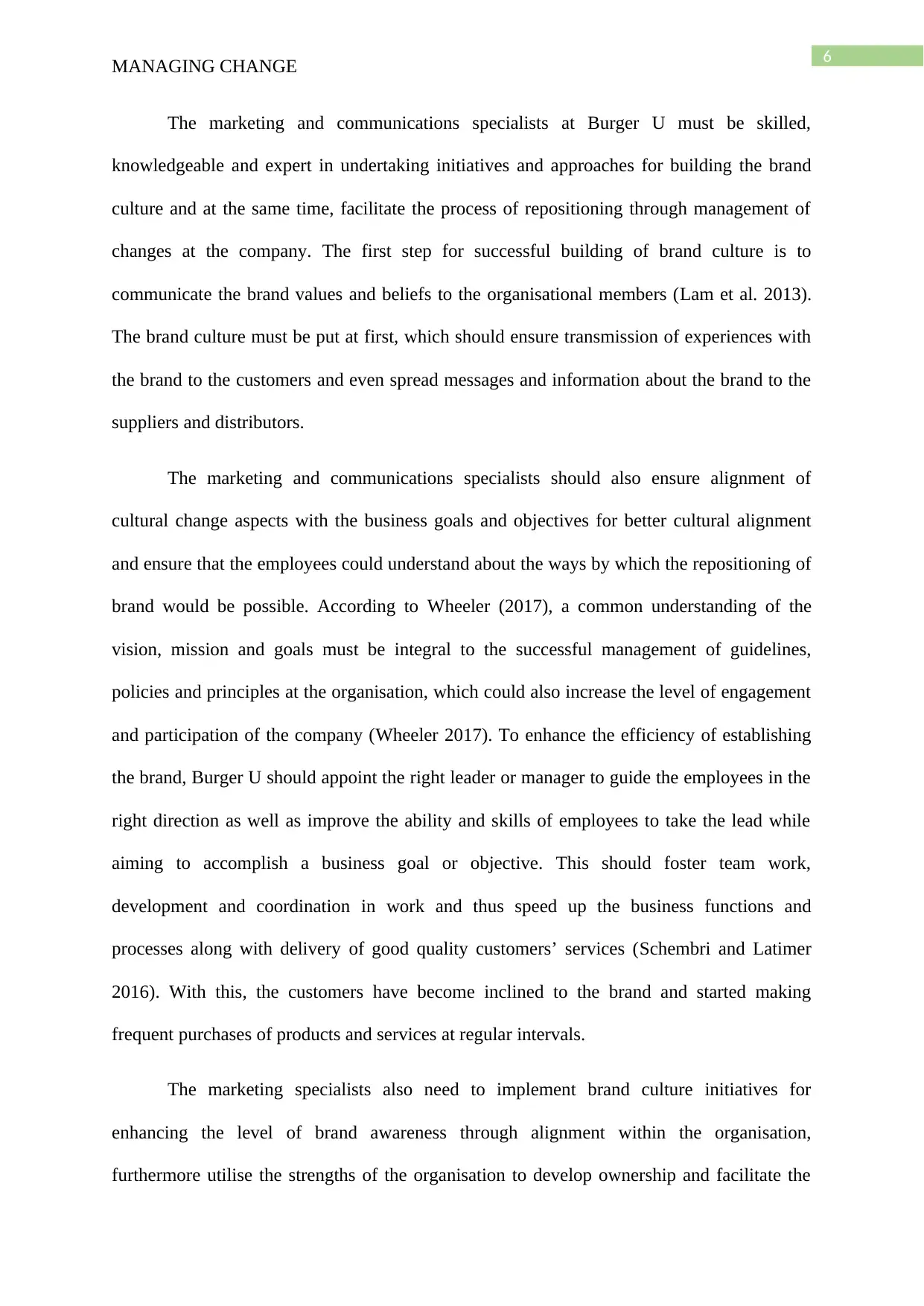
6
MANAGING CHANGE
The marketing and communications specialists at Burger U must be skilled,
knowledgeable and expert in undertaking initiatives and approaches for building the brand
culture and at the same time, facilitate the process of repositioning through management of
changes at the company. The first step for successful building of brand culture is to
communicate the brand values and beliefs to the organisational members (Lam et al. 2013).
The brand culture must be put at first, which should ensure transmission of experiences with
the brand to the customers and even spread messages and information about the brand to the
suppliers and distributors.
The marketing and communications specialists should also ensure alignment of
cultural change aspects with the business goals and objectives for better cultural alignment
and ensure that the employees could understand about the ways by which the repositioning of
brand would be possible. According to Wheeler (2017), a common understanding of the
vision, mission and goals must be integral to the successful management of guidelines,
policies and principles at the organisation, which could also increase the level of engagement
and participation of the company (Wheeler 2017). To enhance the efficiency of establishing
the brand, Burger U should appoint the right leader or manager to guide the employees in the
right direction as well as improve the ability and skills of employees to take the lead while
aiming to accomplish a business goal or objective. This should foster team work,
development and coordination in work and thus speed up the business functions and
processes along with delivery of good quality customers’ services (Schembri and Latimer
2016). With this, the customers have become inclined to the brand and started making
frequent purchases of products and services at regular intervals.
The marketing specialists also need to implement brand culture initiatives for
enhancing the level of brand awareness through alignment within the organisation,
furthermore utilise the strengths of the organisation to develop ownership and facilitate the
MANAGING CHANGE
The marketing and communications specialists at Burger U must be skilled,
knowledgeable and expert in undertaking initiatives and approaches for building the brand
culture and at the same time, facilitate the process of repositioning through management of
changes at the company. The first step for successful building of brand culture is to
communicate the brand values and beliefs to the organisational members (Lam et al. 2013).
The brand culture must be put at first, which should ensure transmission of experiences with
the brand to the customers and even spread messages and information about the brand to the
suppliers and distributors.
The marketing and communications specialists should also ensure alignment of
cultural change aspects with the business goals and objectives for better cultural alignment
and ensure that the employees could understand about the ways by which the repositioning of
brand would be possible. According to Wheeler (2017), a common understanding of the
vision, mission and goals must be integral to the successful management of guidelines,
policies and principles at the organisation, which could also increase the level of engagement
and participation of the company (Wheeler 2017). To enhance the efficiency of establishing
the brand, Burger U should appoint the right leader or manager to guide the employees in the
right direction as well as improve the ability and skills of employees to take the lead while
aiming to accomplish a business goal or objective. This should foster team work,
development and coordination in work and thus speed up the business functions and
processes along with delivery of good quality customers’ services (Schembri and Latimer
2016). With this, the customers have become inclined to the brand and started making
frequent purchases of products and services at regular intervals.
The marketing specialists also need to implement brand culture initiatives for
enhancing the level of brand awareness through alignment within the organisation,
furthermore utilise the strengths of the organisation to develop ownership and facilitate the
Paraphrase This Document
Need a fresh take? Get an instant paraphrase of this document with our AI Paraphraser
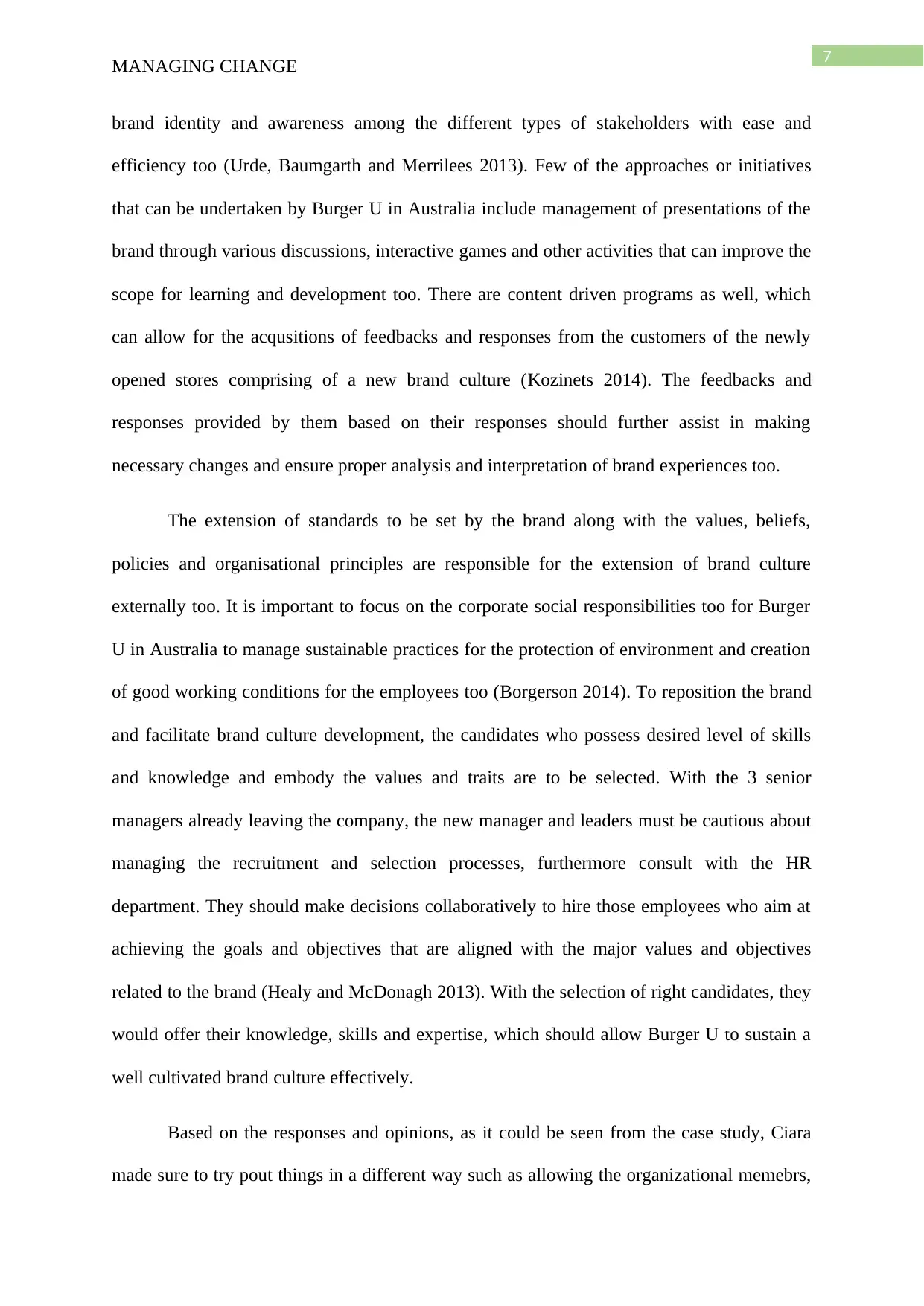
7
MANAGING CHANGE
brand identity and awareness among the different types of stakeholders with ease and
efficiency too (Urde, Baumgarth and Merrilees 2013). Few of the approaches or initiatives
that can be undertaken by Burger U in Australia include management of presentations of the
brand through various discussions, interactive games and other activities that can improve the
scope for learning and development too. There are content driven programs as well, which
can allow for the acqusitions of feedbacks and responses from the customers of the newly
opened stores comprising of a new brand culture (Kozinets 2014). The feedbacks and
responses provided by them based on their responses should further assist in making
necessary changes and ensure proper analysis and interpretation of brand experiences too.
The extension of standards to be set by the brand along with the values, beliefs,
policies and organisational principles are responsible for the extension of brand culture
externally too. It is important to focus on the corporate social responsibilities too for Burger
U in Australia to manage sustainable practices for the protection of environment and creation
of good working conditions for the employees too (Borgerson 2014). To reposition the brand
and facilitate brand culture development, the candidates who possess desired level of skills
and knowledge and embody the values and traits are to be selected. With the 3 senior
managers already leaving the company, the new manager and leaders must be cautious about
managing the recruitment and selection processes, furthermore consult with the HR
department. They should make decisions collaboratively to hire those employees who aim at
achieving the goals and objectives that are aligned with the major values and objectives
related to the brand (Healy and McDonagh 2013). With the selection of right candidates, they
would offer their knowledge, skills and expertise, which should allow Burger U to sustain a
well cultivated brand culture effectively.
Based on the responses and opinions, as it could be seen from the case study, Ciara
made sure to try pout things in a different way such as allowing the organizational memebrs,
MANAGING CHANGE
brand identity and awareness among the different types of stakeholders with ease and
efficiency too (Urde, Baumgarth and Merrilees 2013). Few of the approaches or initiatives
that can be undertaken by Burger U in Australia include management of presentations of the
brand through various discussions, interactive games and other activities that can improve the
scope for learning and development too. There are content driven programs as well, which
can allow for the acqusitions of feedbacks and responses from the customers of the newly
opened stores comprising of a new brand culture (Kozinets 2014). The feedbacks and
responses provided by them based on their responses should further assist in making
necessary changes and ensure proper analysis and interpretation of brand experiences too.
The extension of standards to be set by the brand along with the values, beliefs,
policies and organisational principles are responsible for the extension of brand culture
externally too. It is important to focus on the corporate social responsibilities too for Burger
U in Australia to manage sustainable practices for the protection of environment and creation
of good working conditions for the employees too (Borgerson 2014). To reposition the brand
and facilitate brand culture development, the candidates who possess desired level of skills
and knowledge and embody the values and traits are to be selected. With the 3 senior
managers already leaving the company, the new manager and leaders must be cautious about
managing the recruitment and selection processes, furthermore consult with the HR
department. They should make decisions collaboratively to hire those employees who aim at
achieving the goals and objectives that are aligned with the major values and objectives
related to the brand (Healy and McDonagh 2013). With the selection of right candidates, they
would offer their knowledge, skills and expertise, which should allow Burger U to sustain a
well cultivated brand culture effectively.
Based on the responses and opinions, as it could be seen from the case study, Ciara
made sure to try pout things in a different way such as allowing the organizational memebrs,
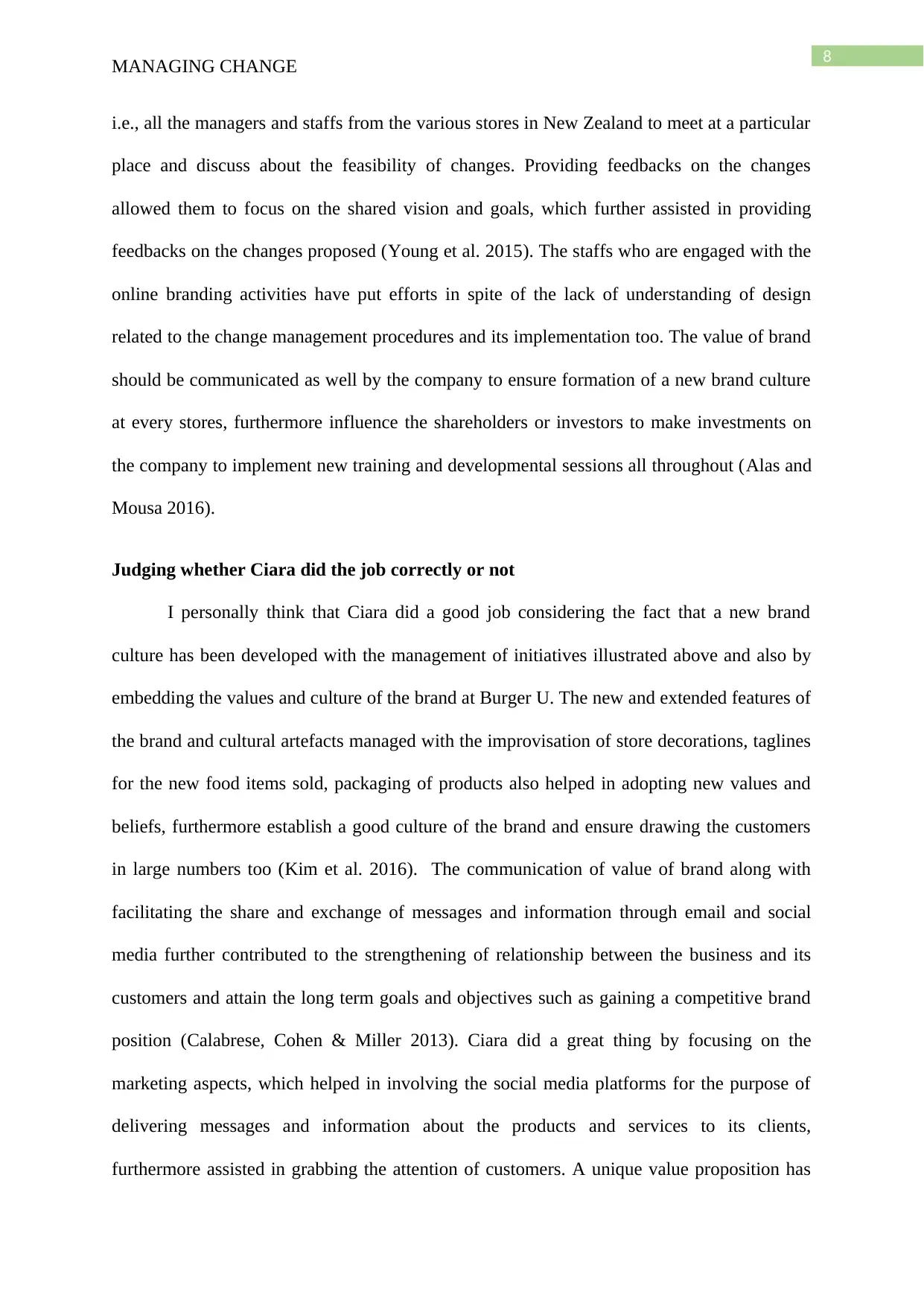
8
MANAGING CHANGE
i.e., all the managers and staffs from the various stores in New Zealand to meet at a particular
place and discuss about the feasibility of changes. Providing feedbacks on the changes
allowed them to focus on the shared vision and goals, which further assisted in providing
feedbacks on the changes proposed (Young et al. 2015). The staffs who are engaged with the
online branding activities have put efforts in spite of the lack of understanding of design
related to the change management procedures and its implementation too. The value of brand
should be communicated as well by the company to ensure formation of a new brand culture
at every stores, furthermore influence the shareholders or investors to make investments on
the company to implement new training and developmental sessions all throughout (Alas and
Mousa 2016).
Judging whether Ciara did the job correctly or not
I personally think that Ciara did a good job considering the fact that a new brand
culture has been developed with the management of initiatives illustrated above and also by
embedding the values and culture of the brand at Burger U. The new and extended features of
the brand and cultural artefacts managed with the improvisation of store decorations, taglines
for the new food items sold, packaging of products also helped in adopting new values and
beliefs, furthermore establish a good culture of the brand and ensure drawing the customers
in large numbers too (Kim et al. 2016). The communication of value of brand along with
facilitating the share and exchange of messages and information through email and social
media further contributed to the strengthening of relationship between the business and its
customers and attain the long term goals and objectives such as gaining a competitive brand
position (Calabrese, Cohen & Miller 2013). Ciara did a great thing by focusing on the
marketing aspects, which helped in involving the social media platforms for the purpose of
delivering messages and information about the products and services to its clients,
furthermore assisted in grabbing the attention of customers. A unique value proposition has
MANAGING CHANGE
i.e., all the managers and staffs from the various stores in New Zealand to meet at a particular
place and discuss about the feasibility of changes. Providing feedbacks on the changes
allowed them to focus on the shared vision and goals, which further assisted in providing
feedbacks on the changes proposed (Young et al. 2015). The staffs who are engaged with the
online branding activities have put efforts in spite of the lack of understanding of design
related to the change management procedures and its implementation too. The value of brand
should be communicated as well by the company to ensure formation of a new brand culture
at every stores, furthermore influence the shareholders or investors to make investments on
the company to implement new training and developmental sessions all throughout (Alas and
Mousa 2016).
Judging whether Ciara did the job correctly or not
I personally think that Ciara did a good job considering the fact that a new brand
culture has been developed with the management of initiatives illustrated above and also by
embedding the values and culture of the brand at Burger U. The new and extended features of
the brand and cultural artefacts managed with the improvisation of store decorations, taglines
for the new food items sold, packaging of products also helped in adopting new values and
beliefs, furthermore establish a good culture of the brand and ensure drawing the customers
in large numbers too (Kim et al. 2016). The communication of value of brand along with
facilitating the share and exchange of messages and information through email and social
media further contributed to the strengthening of relationship between the business and its
customers and attain the long term goals and objectives such as gaining a competitive brand
position (Calabrese, Cohen & Miller 2013). Ciara did a great thing by focusing on the
marketing aspects, which helped in involving the social media platforms for the purpose of
delivering messages and information about the products and services to its clients,
furthermore assisted in grabbing the attention of customers. A unique value proposition has
⊘ This is a preview!⊘
Do you want full access?
Subscribe today to unlock all pages.

Trusted by 1+ million students worldwide
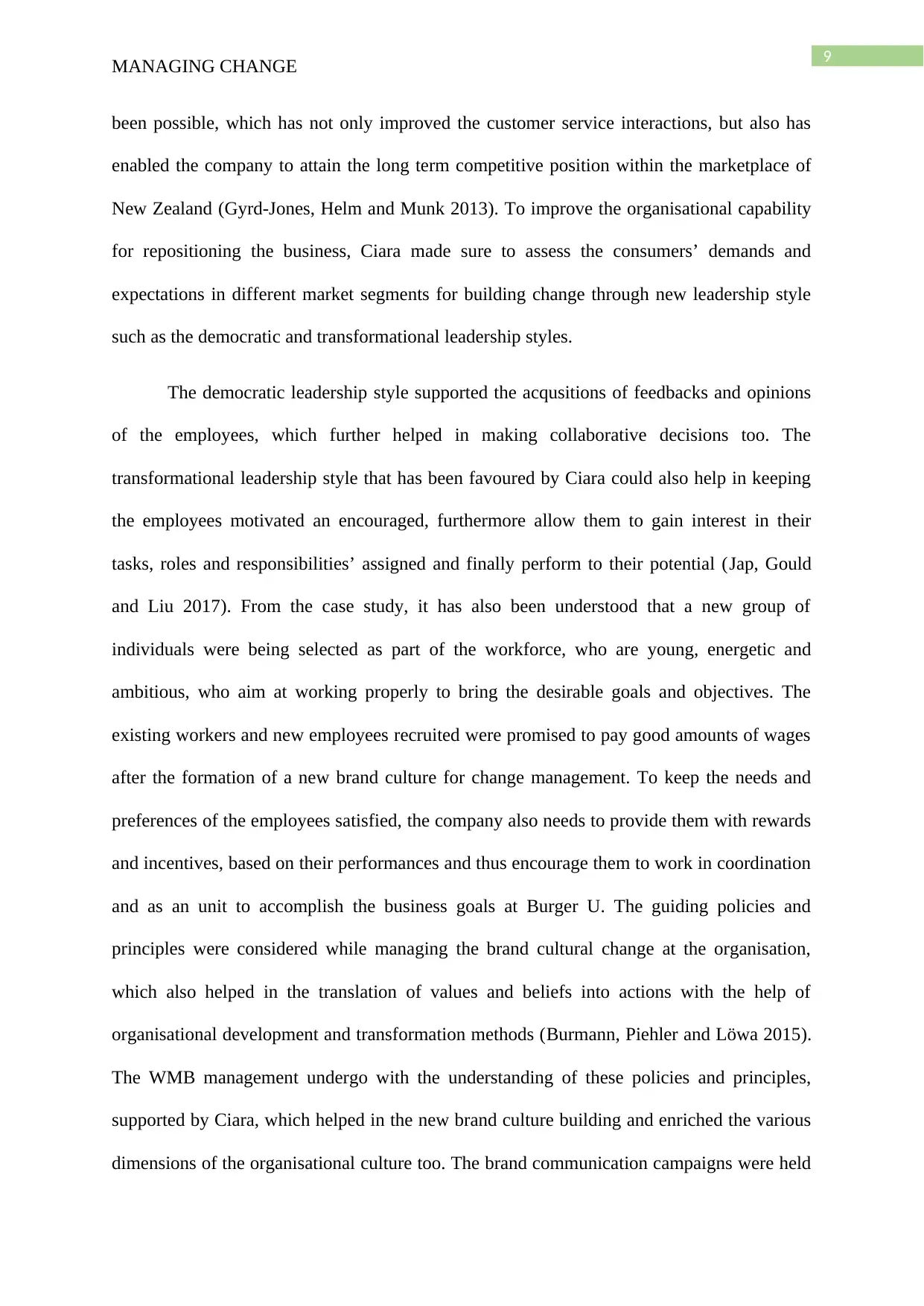
9
MANAGING CHANGE
been possible, which has not only improved the customer service interactions, but also has
enabled the company to attain the long term competitive position within the marketplace of
New Zealand (Gyrd-Jones, Helm and Munk 2013). To improve the organisational capability
for repositioning the business, Ciara made sure to assess the consumers’ demands and
expectations in different market segments for building change through new leadership style
such as the democratic and transformational leadership styles.
The democratic leadership style supported the acqusitions of feedbacks and opinions
of the employees, which further helped in making collaborative decisions too. The
transformational leadership style that has been favoured by Ciara could also help in keeping
the employees motivated an encouraged, furthermore allow them to gain interest in their
tasks, roles and responsibilities’ assigned and finally perform to their potential (Jap, Gould
and Liu 2017). From the case study, it has also been understood that a new group of
individuals were being selected as part of the workforce, who are young, energetic and
ambitious, who aim at working properly to bring the desirable goals and objectives. The
existing workers and new employees recruited were promised to pay good amounts of wages
after the formation of a new brand culture for change management. To keep the needs and
preferences of the employees satisfied, the company also needs to provide them with rewards
and incentives, based on their performances and thus encourage them to work in coordination
and as an unit to accomplish the business goals at Burger U. The guiding policies and
principles were considered while managing the brand cultural change at the organisation,
which also helped in the translation of values and beliefs into actions with the help of
organisational development and transformation methods (Burmann, Piehler and Löwa 2015).
The WMB management undergo with the understanding of these policies and principles,
supported by Ciara, which helped in the new brand culture building and enriched the various
dimensions of the organisational culture too. The brand communication campaigns were held
MANAGING CHANGE
been possible, which has not only improved the customer service interactions, but also has
enabled the company to attain the long term competitive position within the marketplace of
New Zealand (Gyrd-Jones, Helm and Munk 2013). To improve the organisational capability
for repositioning the business, Ciara made sure to assess the consumers’ demands and
expectations in different market segments for building change through new leadership style
such as the democratic and transformational leadership styles.
The democratic leadership style supported the acqusitions of feedbacks and opinions
of the employees, which further helped in making collaborative decisions too. The
transformational leadership style that has been favoured by Ciara could also help in keeping
the employees motivated an encouraged, furthermore allow them to gain interest in their
tasks, roles and responsibilities’ assigned and finally perform to their potential (Jap, Gould
and Liu 2017). From the case study, it has also been understood that a new group of
individuals were being selected as part of the workforce, who are young, energetic and
ambitious, who aim at working properly to bring the desirable goals and objectives. The
existing workers and new employees recruited were promised to pay good amounts of wages
after the formation of a new brand culture for change management. To keep the needs and
preferences of the employees satisfied, the company also needs to provide them with rewards
and incentives, based on their performances and thus encourage them to work in coordination
and as an unit to accomplish the business goals at Burger U. The guiding policies and
principles were considered while managing the brand cultural change at the organisation,
which also helped in the translation of values and beliefs into actions with the help of
organisational development and transformation methods (Burmann, Piehler and Löwa 2015).
The WMB management undergo with the understanding of these policies and principles,
supported by Ciara, which helped in the new brand culture building and enriched the various
dimensions of the organisational culture too. The brand communication campaigns were held
Paraphrase This Document
Need a fresh take? Get an instant paraphrase of this document with our AI Paraphraser
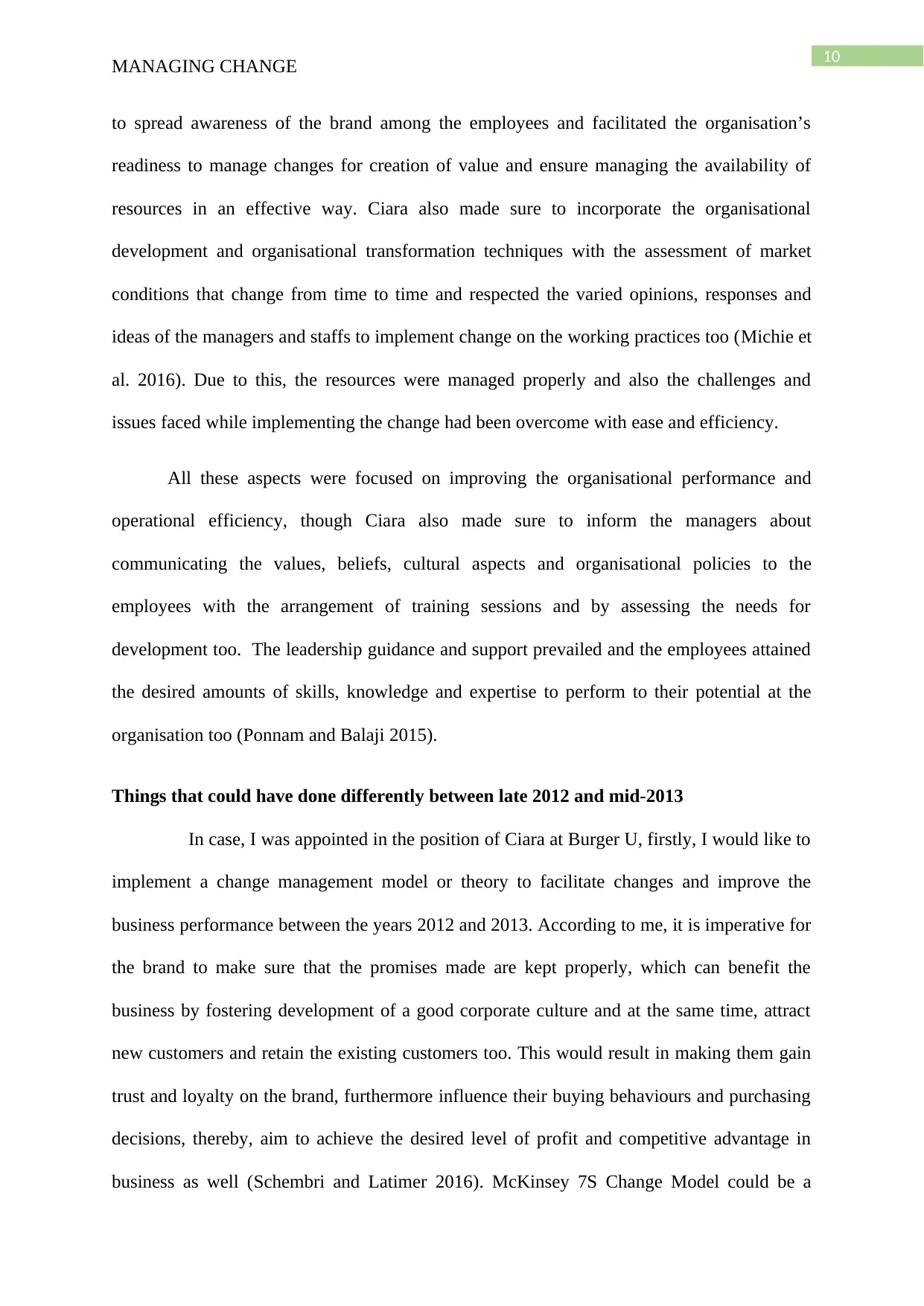
10
MANAGING CHANGE
to spread awareness of the brand among the employees and facilitated the organisation’s
readiness to manage changes for creation of value and ensure managing the availability of
resources in an effective way. Ciara also made sure to incorporate the organisational
development and organisational transformation techniques with the assessment of market
conditions that change from time to time and respected the varied opinions, responses and
ideas of the managers and staffs to implement change on the working practices too (Michie et
al. 2016). Due to this, the resources were managed properly and also the challenges and
issues faced while implementing the change had been overcome with ease and efficiency.
All these aspects were focused on improving the organisational performance and
operational efficiency, though Ciara also made sure to inform the managers about
communicating the values, beliefs, cultural aspects and organisational policies to the
employees with the arrangement of training sessions and by assessing the needs for
development too. The leadership guidance and support prevailed and the employees attained
the desired amounts of skills, knowledge and expertise to perform to their potential at the
organisation too (Ponnam and Balaji 2015).
Things that could have done differently between late 2012 and mid-2013
In case, I was appointed in the position of Ciara at Burger U, firstly, I would like to
implement a change management model or theory to facilitate changes and improve the
business performance between the years 2012 and 2013. According to me, it is imperative for
the brand to make sure that the promises made are kept properly, which can benefit the
business by fostering development of a good corporate culture and at the same time, attract
new customers and retain the existing customers too. This would result in making them gain
trust and loyalty on the brand, furthermore influence their buying behaviours and purchasing
decisions, thereby, aim to achieve the desired level of profit and competitive advantage in
business as well (Schembri and Latimer 2016). McKinsey 7S Change Model could be a
MANAGING CHANGE
to spread awareness of the brand among the employees and facilitated the organisation’s
readiness to manage changes for creation of value and ensure managing the availability of
resources in an effective way. Ciara also made sure to incorporate the organisational
development and organisational transformation techniques with the assessment of market
conditions that change from time to time and respected the varied opinions, responses and
ideas of the managers and staffs to implement change on the working practices too (Michie et
al. 2016). Due to this, the resources were managed properly and also the challenges and
issues faced while implementing the change had been overcome with ease and efficiency.
All these aspects were focused on improving the organisational performance and
operational efficiency, though Ciara also made sure to inform the managers about
communicating the values, beliefs, cultural aspects and organisational policies to the
employees with the arrangement of training sessions and by assessing the needs for
development too. The leadership guidance and support prevailed and the employees attained
the desired amounts of skills, knowledge and expertise to perform to their potential at the
organisation too (Ponnam and Balaji 2015).
Things that could have done differently between late 2012 and mid-2013
In case, I was appointed in the position of Ciara at Burger U, firstly, I would like to
implement a change management model or theory to facilitate changes and improve the
business performance between the years 2012 and 2013. According to me, it is imperative for
the brand to make sure that the promises made are kept properly, which can benefit the
business by fostering development of a good corporate culture and at the same time, attract
new customers and retain the existing customers too. This would result in making them gain
trust and loyalty on the brand, furthermore influence their buying behaviours and purchasing
decisions, thereby, aim to achieve the desired level of profit and competitive advantage in
business as well (Schembri and Latimer 2016). McKinsey 7S Change Model could be a
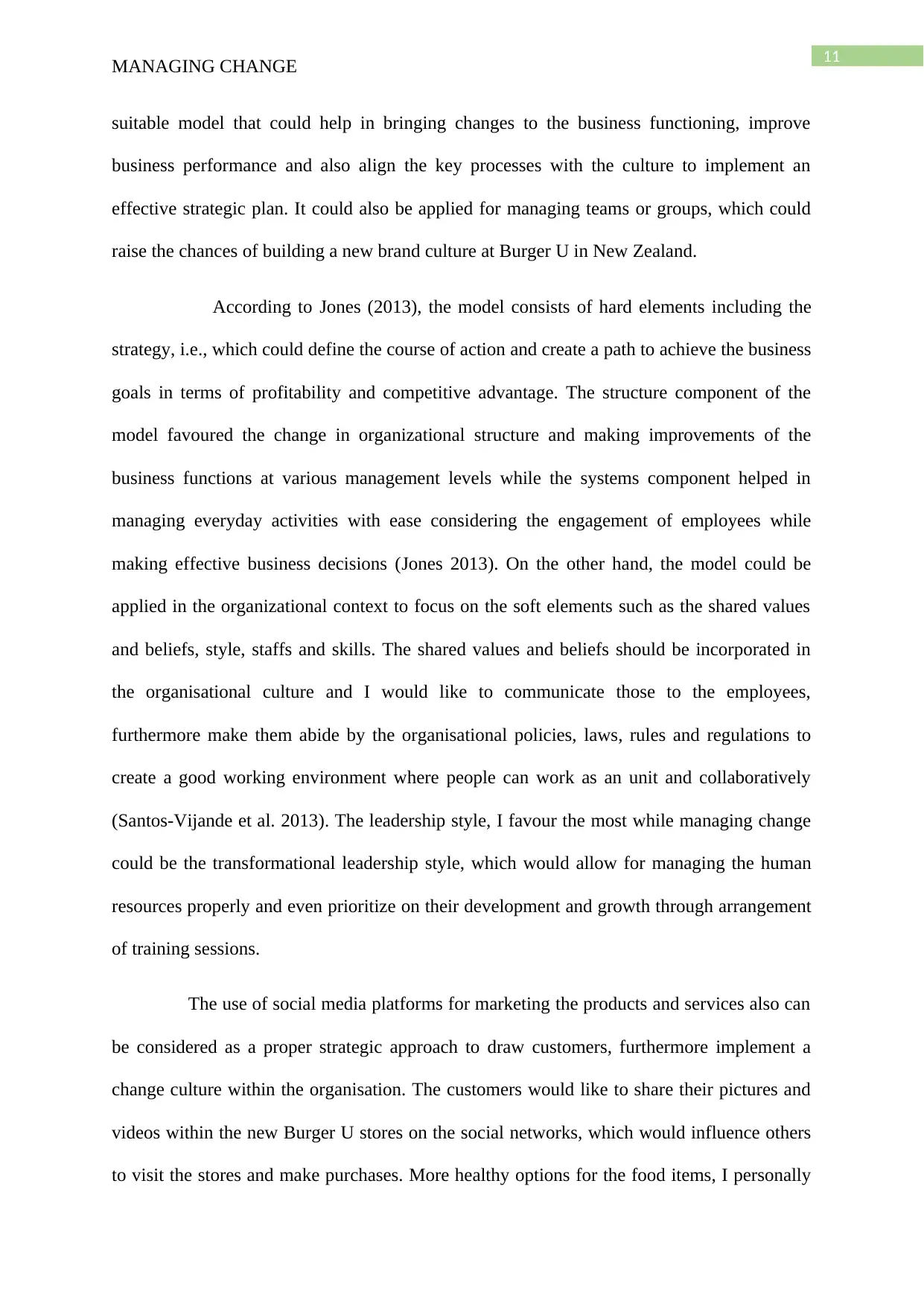
11
MANAGING CHANGE
suitable model that could help in bringing changes to the business functioning, improve
business performance and also align the key processes with the culture to implement an
effective strategic plan. It could also be applied for managing teams or groups, which could
raise the chances of building a new brand culture at Burger U in New Zealand.
According to Jones (2013), the model consists of hard elements including the
strategy, i.e., which could define the course of action and create a path to achieve the business
goals in terms of profitability and competitive advantage. The structure component of the
model favoured the change in organizational structure and making improvements of the
business functions at various management levels while the systems component helped in
managing everyday activities with ease considering the engagement of employees while
making effective business decisions (Jones 2013). On the other hand, the model could be
applied in the organizational context to focus on the soft elements such as the shared values
and beliefs, style, staffs and skills. The shared values and beliefs should be incorporated in
the organisational culture and I would like to communicate those to the employees,
furthermore make them abide by the organisational policies, laws, rules and regulations to
create a good working environment where people can work as an unit and collaboratively
(Santos-Vijande et al. 2013). The leadership style, I favour the most while managing change
could be the transformational leadership style, which would allow for managing the human
resources properly and even prioritize on their development and growth through arrangement
of training sessions.
The use of social media platforms for marketing the products and services also can
be considered as a proper strategic approach to draw customers, furthermore implement a
change culture within the organisation. The customers would like to share their pictures and
videos within the new Burger U stores on the social networks, which would influence others
to visit the stores and make purchases. More healthy options for the food items, I personally
MANAGING CHANGE
suitable model that could help in bringing changes to the business functioning, improve
business performance and also align the key processes with the culture to implement an
effective strategic plan. It could also be applied for managing teams or groups, which could
raise the chances of building a new brand culture at Burger U in New Zealand.
According to Jones (2013), the model consists of hard elements including the
strategy, i.e., which could define the course of action and create a path to achieve the business
goals in terms of profitability and competitive advantage. The structure component of the
model favoured the change in organizational structure and making improvements of the
business functions at various management levels while the systems component helped in
managing everyday activities with ease considering the engagement of employees while
making effective business decisions (Jones 2013). On the other hand, the model could be
applied in the organizational context to focus on the soft elements such as the shared values
and beliefs, style, staffs and skills. The shared values and beliefs should be incorporated in
the organisational culture and I would like to communicate those to the employees,
furthermore make them abide by the organisational policies, laws, rules and regulations to
create a good working environment where people can work as an unit and collaboratively
(Santos-Vijande et al. 2013). The leadership style, I favour the most while managing change
could be the transformational leadership style, which would allow for managing the human
resources properly and even prioritize on their development and growth through arrangement
of training sessions.
The use of social media platforms for marketing the products and services also can
be considered as a proper strategic approach to draw customers, furthermore implement a
change culture within the organisation. The customers would like to share their pictures and
videos within the new Burger U stores on the social networks, which would influence others
to visit the stores and make purchases. More healthy options for the food items, I personally
⊘ This is a preview!⊘
Do you want full access?
Subscribe today to unlock all pages.

Trusted by 1+ million students worldwide
1 out of 16
Related Documents
Your All-in-One AI-Powered Toolkit for Academic Success.
+13062052269
info@desklib.com
Available 24*7 on WhatsApp / Email
![[object Object]](/_next/static/media/star-bottom.7253800d.svg)
Unlock your academic potential
Copyright © 2020–2025 A2Z Services. All Rights Reserved. Developed and managed by ZUCOL.





